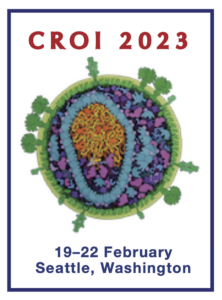CROI 2023: Yet more evidence for recycled tenofovir and 3TC or FTC with dolutegravir in second-line: 48 week results from the D2EFT study
10 March 2023. Related: Conference reports, Treatment strategies, Drug resistance, CROI 30 Seattle 2023.
Polly Clayden, HIV i-Base
 A switch to dolutegravir (DTG), tenofovir disoproxil fumarate (TDF) and lamivudine or emtricitabine (XTC), without universal access to genotyping, was non-inferior to ritonavir-boosted darunavir (DRV/r) and two NRTIs – according to findings from the D2EFT study, presented at CROI 2023. [1]
A switch to dolutegravir (DTG), tenofovir disoproxil fumarate (TDF) and lamivudine or emtricitabine (XTC), without universal access to genotyping, was non-inferior to ritonavir-boosted darunavir (DRV/r) and two NRTIs – according to findings from the D2EFT study, presented at CROI 2023. [1]
The study included a third arm with DTG + DRV/r, which also performed well.
D2FT is an international randomised open-label study comparing DTG + DRV/r vs DTG/TDF/FTC vs standard of care (SOC: DRV/r + 2 genotype-guided NRTIs) in adults living with HIV whose first-line ART has failed.
The study was originally conceived as a two-arm study comparing DTG/DRV/r vs SOC (stage 1) that started in April 2017. In response to requests from stakeholders and a changing treatment landscape – notably with the rapid roll out of DTG – the D2EFT group adapted the trial to include a third arm, which commenced in September 2018 (DTG/TDF/XTC, stage 2).
The study was designed to show non-inferiority to SOC: viral load <50 copies/mL at 48 weeks (12% margin). Primary outcome data were presented as modified ITT analysis, including all available data.
A total of 831 participants (722 in stage 2) from 14 countries across Asia, Africa and Latin America, were randomised between 2017 and January 2022. Despite challenges – including two pauses, first because of the adapted trial design and the second due to covid – retention was excellent, with only seven withdrawals and three participants lost to follow up.
Median age was just under 40 years, about 55% were women and just under 70% were black African. Median CD4 was 206 cells/mm3 and median viral load 4.2 log10 copies/mL. The majority (82.7%) had received an efavirenz (EFV)-based first-line ART. In the SOC arm the NRTIs were 76% AZT/3TC and 19% TDF/XTC.
At week 48, the proportion with <50 copies/mL in stage 1 was 75.4% (194/257) SOC vs 84.1% (222/264) DTG + DRV/r. In stage 2 , 71.4% (147/206) SOC vs 84.7% (177/209) DTG + DRV/r vs 78.0% (227/291) DTG/TDF/XTC.
Compared to SOC, the % difference in <50 copies/mL was -8.6% for DTG + DRV/r, and -6.7% for DTG/TDF/XTC.
Mean CD4 gain at week 48 was significantly greater in both DTG arms compared to SOC (stage 2 only): DTG + DRV/r, 56.0 cells/mm3 (p<0.001) and DTG/TDF/XTC, 39.9 cells/mm3 (p=0.01).
Mean weight change was also greater in the DTG arms compared to SOC: DTG + DRV/r, 2.7 kg (p<0.001) and DTG/TDF/XTC, 1.7 kg (p=0.006)
There were 14 deaths (none treatment related) and 97 SAEs (14 possibly treatment related) in the study. And there were 35 pregnancies (24 deliveries), 25 were DTG exposed, with no congenital defects .
comment
These data add to the evidence from NADIA, VISEND and ARTIST supporting the use of DTG plus recycled TDF/3TC second-line, for people whose EFV-based first-line has failed. [2–8]
As well as non-inferiority, DTG + DRV/r reached criteria for superiority, but wide availability of TLD as a low cost fixed-dose combination makes this regimen far more attractive for programmes and countries.
Like NADIA and VISEND, D2EFT also supports DRV/r use second-line and this PI really needs to recommended as a preferred, rather than alternative, PI by WHO. Demand for this change from African activists continues. [9]
In NADIA, TDF/3TC was superior to AZT/3TC with DRV/r and it would be interesting to see if the same is true in D2EFT.
D2FT participants will be followed to week 96 and the investigators are looking at body composition, PK resistance and HRQOL.
References
Unless stated otherwise, references are to the Programme and Abstracts of the 30th Conference on Retroviruses and Opportunistic Infections, 19 – 22 February 2023, Seattle and hybrid. Some 2023 abstracts are available via the online CROI abstract database.
www.croiconference.org/search-abstracts
- Matthews G et al. D2EFT: dolutegravir and darunavir evaluation in adults failing first-line HIV therapy. 30th CROI, 19–22 February 2023, Seattle (CROI 2023). Oral abstract 198.
https://www.croiconference.org/abstract/d2eft-dolutegravir-and-darunavir-evaluation-in-adults-failing-first-line-hiv-therapy - Clayden P. Dolutegravir with recycled tenofovir and lamivudine performs well second-line: primary results from the NADIA trial. HTB. 12 March 202
https://i-base.info/htb/40165 - Clayden P. Dolutegravir plus recycled tenofovir rather than switch to AZT: public health approach to second-line ART. HTB. 2 May 2022.
https://i-base.info/htb/42725 - Paton NI et al. Efficacy and safety of dolutegravir or darunavir in combination with lamivudine plus either zidovudine or tenofovir for second-line treatment of HIV infection (NADIA): week 96 results from a prospective, multicentre, open-label, factorial, randomised, non. Lancet HIV. 20 April. 2022.
https://www.thelancet.com/journals/lanhiv/article/PIIS2352-3018(22)00092-3/fulltext - Mulenga L et al. Dolutegravir with recycled NRTIsis noninferior toPI-based ART: VISEND trial. CROI 2022. 12–16 February. Virtual. Oral abstract 135.
https://www.croiconference.org/abstract/dolutegravir-with-recycled-nrtis-is-noninferior-to-pi-based-art-visend-trial/ (abstract)
http://www.croiwebcasts.org/console/player/50578 (webcast) - Clayden P. More evidence for recycling tenofovir in second-line ART with dolutegravir: 72-week results from ARTIST study. HTB. 1 February 2023.
https://i-base.info/htb/44763 - Keene CM et al. Recycling tenofovir in second-line antiretroviral treatment with dolutegravir: outcomes and viral load trajectories to 72 weeks. JAIDS. Publish ahead of print. 25 January 2023.
https://journals.lww.com/jaids/Abstract/9900/Recycling_tenofovir_in_second_line_antiretroviral.176.aspx - Keene CM et al. Virologic efficacy of tenofovir, lamivudine and dolutegravir as second-line in adults failing a tenofovir-based first-line regimen: a prospective cohort study. AIDS. 2021;35(9):1423-1432. (15 July 2021).
https://journals.lww.com/aidsonline/Fulltext/2021/07150/Virologic_efficacy_of_tenofovir,_lamivudine_and.10.aspx - Time for the World Health Organization (WHO) to start providing leadership on second-line (2L) HIV treatment: An open letter to the WHO. 22 February 2023.
https://acrobat.adobe.com/link/review?uri=urn:aaid:scds:US:8d01d50a-7ff6-43ea-be31-8a548cc12ef1
This report was first posted on 22 February 2023.</em

